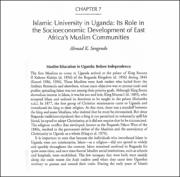Islamic University in Uganda: Its Role in the Socioeconomic Development of East Africa’s Muslim Communities
Abstract
The first Muslims to come to Uganda arrived at the palace of King Ssuuna II Kalema Kisinjo (d. 1856) of the Buganda Kingdom (d. 1856) during 1844 (Kasozi 1986, 1996). These Muslims were Arab traders who hailed from the Arabian Peninsula and elsewhere, whose main objective was to pursue trade and profits; spreading Islam was not among their priority goals. Although King Ssuna showed an interest in Islam, it was his son and heir, King Mutesa I (d. 1884), who accepted Islam and ordered its doctrines to be taught in the palace (Kulumba n.d.). In 1877, the first group of Christian missionaries came to Uganda and introduced the king to their religion. At that time, there was a standoff between the king and some Muslims, who insisted that he must be circumcised. But since Buganda traditions stipulated that a king is not permitted to voluntarily spill his blood, he opted to adopt Christianity, as it did not require that he be circumcised. The religious conflict that developed, known as the Buganda Palace Wars of the 1880s, resulted in the permanent defeat of the Muslims and the ascendancy of Christianity in Uganda as a whole (King et al. 1973).
Collections
- Research Papers [35]

